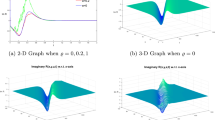Conclusions
Generalizing our results, one can identify the basic mechanism responsible for the mutual influence of temporal and spatial fluctuations in the amplitude of a light field in a moving medium with thermal nonlinearity.
A necessary condition for this type of mutual interaction is a nonlinear incoherent effect connected nonlinearly with the induced fluctuations in the refractive index nnℓ. The mutual coupling of temporal and spatial variations is detectable only when the fluctuating part of nnℓ is comparable in magnitude to the normal refractive index, and when the distribution is nonuniform over the beam cross section and unstable during the pulse.
The fundamental relationships of mutual interaction are that the slow fluctuations, which “peel” off the nonlinear medium over time, lead to a degradation of the spatial coherence of the light beam while it is being nonlinearly refracted. In all cases the spatial coherence of the laser radiation is reduced. The reverse effect of spatial fluctuations on the degradation of temporal coherence of a light pulse that is spatially-incoherent at the entrance to the medium is similar in its characteristics. This mutual interaction is substantially reduced when the nonstationary self-interaction regime promotes smoothing of fluctuations in the induced optical channel.
Finally, we note that if the noise component of the pulse is a stable, uniform process, the transformations of the temporal and spatial coherence of a light field will occur independently in a nonlinear medium.
Similar content being viewed by others
Literature Cited
A. S. Chirkin and F. M. Yusubov, Zh. Éksp. Teor. Fiz. Pis'ma Red.,7, 13 (1981).
B. S. Agrovskii, V. V. Vorob'ev, A. S. Gurvich, V. V. Pokasov, and A. N. Ushakov, Sov. J. Quantum Electron.,7, 545 (1980).
A. S. Chirkin and F. M. Yusubov, Sov. J. Quantum Electron.,10, 1833 (1983).
V. P. Kandidov and V. I. Lednev, Sov. J. Quantum Electron.,8, 873 (1981).
K. D. Egorov and V. P. Kandidov, Izv. Vyssh. Uchebn. Zaved., Radiofiz.,23, 801 (1980).
V. A. Aleshkevich, G. D. Kozhoridze, A. N. Matveev, and S. I. Terzieva, Sov. J. Quantum Electron.,12, 192 (1985).
V. A. Aleshkevich, G. D. Kozhoridze, and A. N. Matveev, Sov. J. Quantum Electron.,12, 1695 (1985).
V. A. Aleshkevich, G. D. Kozhoridze, and A. N. Matveev, All-Union Conference on Laser Optics, Leningrad (1987), p. 131.
J. A. Fleck, J. R. Morris, and M. P. Feit, Appl. Phys.,10, 2 (1976).
S. A. Akhmanov, Yu. E. D'yakov, and A. S. Chirkin, Introduction to Statistical Radiophysics and Optics [in Russian], Nauka, Moscow (1981).
Additional information
Moscow State University. Translated from Izvestiya Vysshikh Uchebnykh Zavedenii, Radiofizika, Vol. 32, No. 7, pp. 816–822, July, 1989.
Rights and permissions
About this article
Cite this article
Aleshkevich, V.A., Kozhoridze, G.D. & Matveev, A.N. Mutual effects of temporal and spatial coherence of laser radiation during wind refraction. Radiophys Quantum Electron 32, 606–611 (1989). https://doi.org/10.1007/BF01058126
Received:
Issue Date:
DOI: https://doi.org/10.1007/BF01058126




